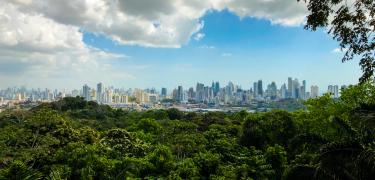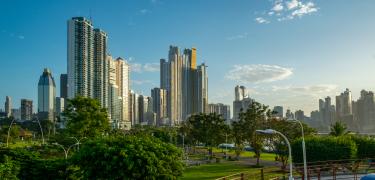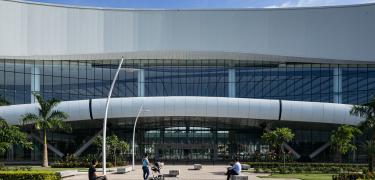Birdwatching in Bocas del Toro
If you are one of those who travel with binoculars in hand and know birds by species, you will love Bocas del Toro. Its territory is home to 778 species–a very high record and one of the many reasons why birding is so popular in the region.
Such abundance is no coincidence. Two crucial areas are located in Bocas: the Caribbean Watershed of Central America, one of the most important areas in the world for birds of restricted range, and the altitude areas, where there is an abundance of high-altitude birds that occasionally migrate to the lowlands. This is the case of the Bare-necked Umbrellabird (Cephalopterus glabricollis) and the Three-wattled Bellbird (Procnias tricarunculatu), both globally endangered species.
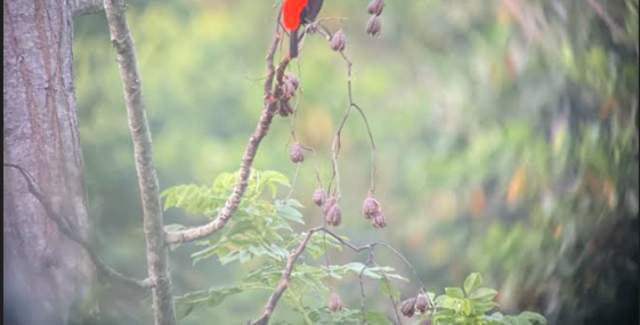
Migratory Birds
To top it off, Bocas del Toro is the stopover for migratory birds that, during September, October and November, leave the north of the continent in search of the warmth of the tropics. Bocas is such a fundamental destination on this route, that since October 2021 there is special monitoring to count the number of birds of prey–experts have counted up to 2 million birds!
In addition, in Bocas del Toro there are two nature conservation areas. The archipelago, with the Isla Bastimento National Marine Park, and the mainland; where the La Amistad International Park (PILA) and the Palo Seco Protected Forest are located. All three are immense refuges for hundreds of bird species and incredible places to spend all day counting for yourself.
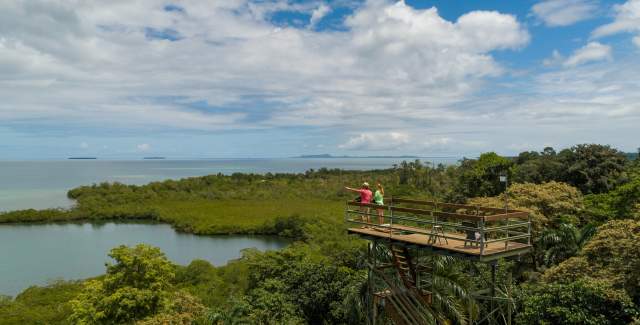
Watch Them From the Archipelago
Although you will always be able to see birds, there are exceptional places in Bocas that are highly visited by bird watching lovers from all over the world. Perhaps the best known is Isla Pájaros, Spanish for “Birds Island”, a rocky territory a short boat ride from Boca del Drago, on Isla Colón.

As its name says, Isla Pájaros is totally taken, full of nests and birds flying over schools of fish that live around it. It is the only place in Panamá where you can see the Red-billed Tropicbird (Phaethon aethereus).
Visit the island at sunset: you will be delighted to see how thousands of birds arrive to their night shelter. The singing, the sound of the wind and the silhouette of the birds flying against the horizon are a spectacle you won't want to miss.
On Isla Bastimento, you can walk through the forest or paddle a kayak through the mangrove labyrinths. Two perfect plans to see a variety of forest birds and seabirds. On Bastimento Island, there is also the Tranquilo Bay observation tower, open to birdwatchers and enthusiasts of all ages. From there you will have a front row view of the birds that inhabit the highest part of the forest.

Twenty miles (thirty-two km) from the Gulf of Los Mosquitos is the Escudo de Veraguas, a remote, spectacular and uninhabited island where the emerald green of the jungle contrasts with the turquoise blue of the Caribbean waters. There you can encounter the Snowy Cotinga (Carpodectes nitidus) and the Uniform Crake (Amaurolimnas concolor), but mostly the Rufous-tailed Hummingbird (Amazilia tzacatl handleyi) - an extremely vulnerable small endemic bird - and three subspecies of birds: the Golden-collared Manakin (Manacus vitellus amitinus), the Chestnut-collared Motmot (Thrythorus nigricapillus oedipus) and the Blue-grey Tanager (Thraupis episcopus caesitia). Isla Escudo de Veraguas may be a bit far away, but that is precisely why it is preserved as a natural jewel.
Another famous island of the Bocas Archipelago is Isla Popa. Experts visit it because of its biogeographic position and because of its 173 recorded bird species.
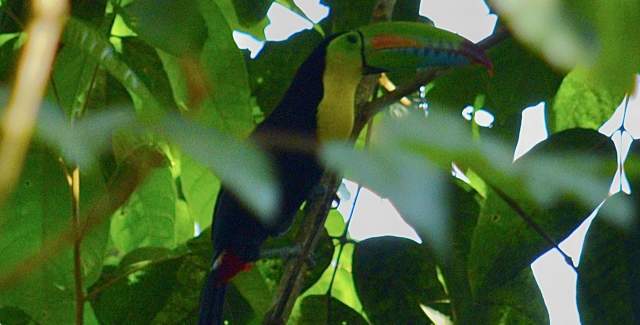
Eyes Open on Mainland
The mainland of Bocas del Toro holds one of the country's most important natural refuges: La Amistad International Park (PILA).
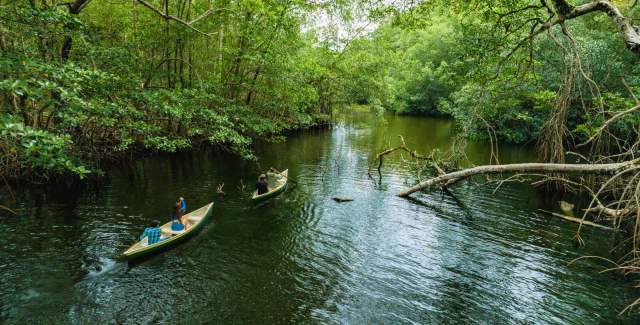
This large territory, which rises to more than 3,300 m, is home to the largest number of endangered birds in the country and is home to 56 endemic species, a number that ranks it among the places with the highest concentration of endemic species in the world.
Plan a boat or kayak expedition in the San San Pond Sak wetland. This mangrove-lined still water will afford you sightings of the Nicaraguan Seed-Finch (Sporophila nuttingi), Canebrake Wren (Cantorchilus zeledoni) and the Black-throated Wren (Pheugopedius atrogularis), among other species. In addition to birds, you will be able to see manatees and learn about this indicator species of marine and ecological well-being.

The Palo Seco forests are home to 83 % of the species found on the Caribbean watershed of Central America. There you can see the Bare-necked Umbrellabird (Cephalopterus glabricollis) and the Three-wattled Bellbird (Procnias tricarunculatu). And in the district of Changuinola, you can enjoy the flight of the Chestnut-colored Woodpecker (Celeus castaneus), the White-collared Manakin (Manacus candei) and the Rufous-winged Woodpecker (Piculus simplex).
Wherever you look, the birds of Bocas del Toro will captivate you. Make sure you have a good pair of binoculars and be ready to take pictures to capture every moment.

